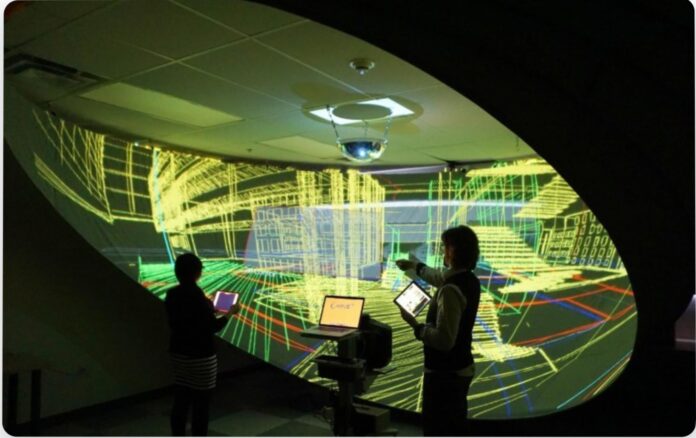Summary:
I put two sources here because both have to do with the HYVE. The first is the website specifically for the HYVE and next is a scholarly journal titled, “Hyve-3D and the 3D Cursor: Architectural co-design with freedom in Virtual Reality” This goes over how to use the HYVE.
“Hybrid Virtual Environment 3D (Hyve-3D) is a system that allows architectural co-design inside Virtual Reality by a new model of interaction through a 3D cursor. It augments the concept of the cursor to better interact with threedimensional virtual spaces, rethinking it as a drawing/control plane and viewpoints inside the virtual world. Handheld tablets intuitively manipulate 3D cursors. Users can simultaneously access their individual complementary views on the tablets as personal windows into the shared immersive display. They can concurrently sketch in three dimensions, transform, and manipulate three-dimensional objects using the tablets as tangible props and collectively navigate the scene using the tablet as a 3D trackpad. The system implementation and co-design assessments of different settings are presented.”
The lack of immersion, the difficulty to represent and understand complex 3D shapes, unintended proportion errors, disregard of the human scale, and the observer’s fixed angle of vision have been described by Landsdown14 as the drawbacks of freehand sketches if we compare them to the advantages offered by VR. Dorta et al. 3 Creating sketches directly in 3D in VR opens up a new dimension in the application of sketching in architectural co-design. Immersive 3D sketching is proposed as an evolution of the traditional 2D sketch.15,16 Totally different from traditional sketching, this approach creates new problems in addition to those of the traditional sketch: control of proportions in perspective view, accuracy in the 3D space, scale, and problems of configuration.
Hyve-3D is specially conceived to support co-design by either using several 3D cursors connected to the same system or interconnecting to remote systems. Using an Internet protocol (IP)-based network, several systems running the same virtual world can be connected. The 3D cursor movements, selections, edition, and so on are synchronized between the systems in real-time. Furthermore, an icon of the point of view of the remote system is displayed to maintain the sense co-presence.”
Analysis
While I explored other aspects of this project, I realized that the core of this project is the HYVE, so I should focus on researching the HYVE itself. It helped me to better understand the possibilities of the system as well as get a breakdown of how to actually use this. I am encouraged to use the HYVE to test out design solutions, so it is important that I know how this system can be used. The journal goes into detail and has image instructions on how to use the 3D cursor which is very helpful. Some things that the journal goes in depth about is 3D sketching, co-design, immersion, co-located configurations for remote collaboration, and working with full scale models.
The website itself gives me an idea of the aesthetics and meaning behind the HYVE, which I hope to channel in the design of the space around it. I want the HYVE to feel like it belongs in the space and that users are welcomed in and not intimidated by it. Watching the videos on the website as well as reading the scholarly journal gives me some context on the main character of the DPP lab.
Source:
HYVE3D. Hyve. (2021, June 23). Retrieved September 1, 2022, from https://www.hyve3d.com/
Dorta, T., Kinayoglu, G., & Hoffmann, M. (2016). HYVE-3D and the 3D cursor: Architectural co-design with freedom in virtual reality. International Journal of Architectural Computing, 14(2), 87–102. https://doi.org/10.1177/1478077116638921




